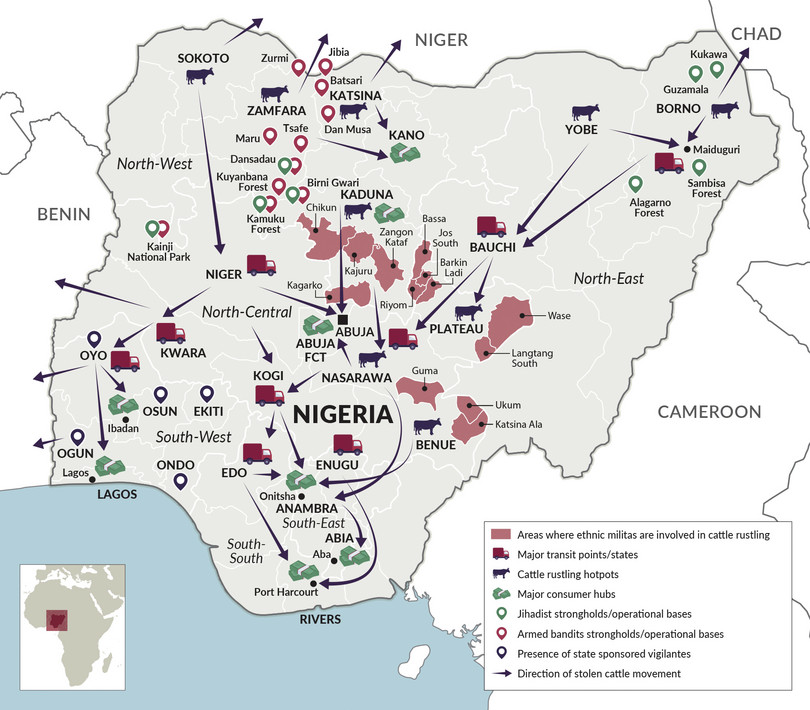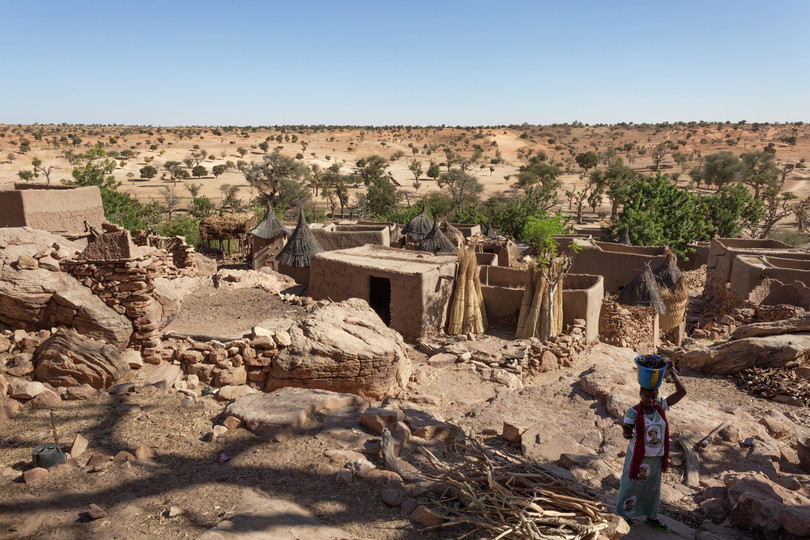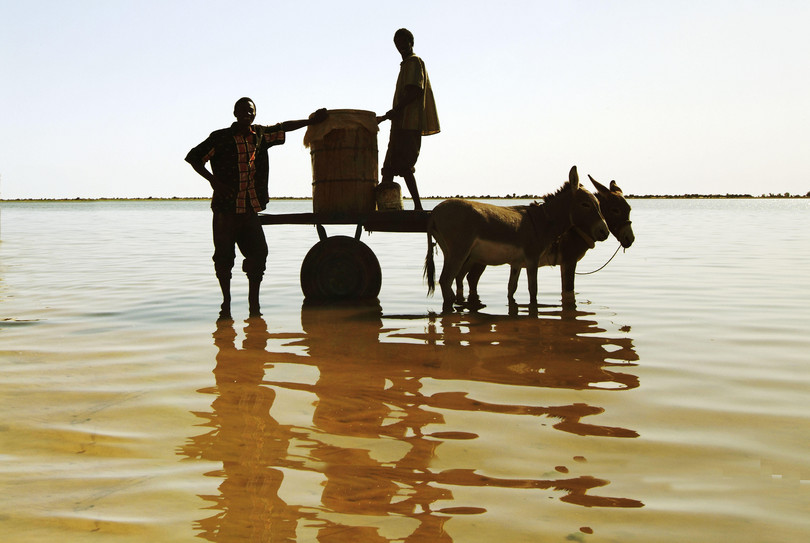With key shifts in dynamics entrenched in 2022, cattle rustling is set to remain a major threat in Nigeria and Mali in 2023.
Not only has cattle rustling caused thousands of deaths, large-scale displacement and destruction of livelihoods across West Africa and the Sahel, but it has also repeatedly operated as a significant source of financing for armed groups.1 The practice is strongly interwoven with longstanding intercommunal tensions in the region, meaning that it acts as a conflict multiplier, triggering vicious cycles of reprisal attacks and swelling conflict.2 In 2022, cattle rustling surged in northern and central Mali, causing a spike in violence, while in Nigeria concerns of southward diffusion grew.
Over the past decade, cattle rustling in the region has evolved from a relatively non-violent practice involving the theft of a small number of cattle into an organized crime featuring high levels of lethal violence by armed groups and operating as a central element of the war economy in several countries. In recent years, cattle rustling dynamics have undergone key shifts in Nigeria and Mali, two of the largest cattle producers in West Africa (see Figure 1) and epicentres of cattle rustling, with the illicit economy now at a key point in its evolution.
Figure 1 Number of cattle by country, 2020.
Source: UN Food and Agricultural Organization (FAO), accessed via Our World in Data, https://ourworldindata.org/grapher/cattle-livestock-count-heads
For the past decade, cattle rustling has been a major source of financing for jihadists, armed bandits and ethnic militias in northern and central Nigeria. Since 2018, however, it has been spreading southwards, fuelling tensions between farmers and herders across a growing area. In Mali, not only is cattle rustling a key source of revenue for non-state armed groups, but it plays a major role as a mechanism for intimidation and criminal governance. In 2022, there was a surge in the number of incidents of violence associated with cattle rustling in Mali.
In both countries the point of entry of armed groups into the cattle rustling market has driven a surge in associated violence, catalyzed a sharp evolution into a more destructive and large-scale manifestation of rustling, and fuelled a wholesale expansion of the market. Similarly, geographic diffusion of intense cattle rusting has characterized Nigeria and Mali, with epicentres of cattle rustling broadly mirroring the areas experiencing the highest levels of violence. The close relationship between cattle rustling and kidnapping, with armed groups switching between the two as primary sources of funding, and arms trafficking also track across the two countries.
In Nigeria, as in Mali, cattle rustling is most entrenched as a form of governance in areas in which armed groups exert a relatively consolidated control over territory. This can be seen in north-east Nigeria, where Islamic State West Africa Province is strongest and is thus able to collect zakat on cattle. In Mali, in areas where JNIM-affiliated Katibat Macina is the primary governance provider, the use of zakat is similarly systematic.
As the illicit economy continues to drive and exacerbate violence, strengthening armed groups, it is now more important than ever to prioritize tackling the issue. Tracking key 2022 trends at the two regional epicentres of cattle rustling – Mali and Nigeria – underscores the urgency dictating the application of a wider toolkit of responses.
Cattle rustling moves southwards in Nigeria
An under-analyzed phenomenon, rampant cattle rustling in Nigeria’s North-West and North-Central regions has not only deeply exacerbated intercommunal conflicts, but has now started to move southwards, driven in large part by desertification and, crucially, rampant insecurity in the north. Cattle rustling has now spread towards Niger, Benue and Kogi states, penetrating the South-West through Kwara and Oyo, where violence between farmers and herders has increased since 2018, and where it experienced a further spike in 2021.3
Currently, the South-West only sees pockets of cattle theft, which are rarer and typically associated with lower levels of violence than in the north. ‘They usually come at night. They steal cows when we are fast asleep,’ according to a community leader in Ogbomosho, Oyo State.4 Nevertheless, the prevalence of cattle rustling in the south-west has increased since 2018.5 Although currently mostly non-violent, rustling incidents could feed into existing grievances and lead to a cycle of reprisal attacks.
Many of the risk factors that preceded the surge in cattle rustling witnessed in the north (in particular, in Zamfara State) are increasingly present in the South-West – namely, intensifying competition over natural resources, including as cattle herds are displaced southwards, and tensions between herders and farming communities. Since 2018, the South-West has experienced a surge in violence between Yoruba farmers and Fulani pastoralists,6 a key risk factor linked to the emergence of large-scale cattle rustling in the North-West and North-Central regions.7 Cattle rustling is interwoven with longstanding tensions between ethnicities, amplifying these and catalyzing further conflict. It is therefore paramount that the widespread farmer-herder tensions that occurred in northern Nigeria is avoided in the south.

Figure 2 Cattle rustling dynamics in Nigeria, 2022.
Source: Kingsley L Madueke, Driving destruction: Cattle rustling and instability in Nigeria, GI-TOC, January 2023
Cattle-related violence spirals in Mali
The year 2021 marked a pivot point in terms of the scale of cattle rustling in both central and northern Mali. Cattle rustling as we know it today has undergone several key phases and changes in its evolution, as explored in a forthcoming GI-TOC research report.8 The main dynamics that have been developing since 2012 – i.e. growth in levels of violence, degree of weaponization, close link with kidnappings, shifts in the types of cattle rustling (from rustling to looting) – have not only continued in recent years, but have accelerated, becoming more entrenched. In 2021, levels of violence and cattle rustling significantly surpassed those of previous years, and official data from the last quarter of 2022 indicates thefts are likely to have exceeded 2021 numbers.9
Locations experiencing an increase in cattle rustling also witnessed a rise in levels of violence, the epicentres being Mopti region in central Mali and the Malian side of the Liptako-Gourma area (covering parts of Gao and Ménaka regions). As attacks against communities and villages grew in number and intensity, cattle rustling – a systemic element of these incidents – intensified in parallel (for example, in Ansongo – see Figure 3). In north-eastern Mali, a higher rate of attacks and accelerating geographic expansion, especially by the Islamic State in the Greater Sahara, which has capitalized on the void left by France’s troop withdrawal in August 2022, has led to a greater demand for resources. Livestock – abundant in the region and easily sold thanks to existing networks specialized in selling or laundering the animals – is a key resource used for buying weapons, motorbikes, fuel and food.
Figure 3 Livestock theft in Gao and Ansongo districts, 2019 and 2022.
Note: Data includes cattle, camels, sheep, goats and donkeys. *Data includes January to October.
Source: Mali - réponse conjointe 2020: Soutenir les activités agricoles et pastorales des ménages touchés par la crise dans les régions de Kayes et de Mopti, FAO, 2020, https://www.fao.org/publications/card/en/c/CA8125FR; Direction régionale des productions et des industries animales – Gao
Interviews have indicated that, in central Mali, the increased operations of the Malian armed forces (FAMa), pro-government self-defence militias and, since the beginning of the year, their Russian partners through the Wagner Group have been partly behind the increase in cattle rustling incidents.10 The trend of looting livestock and other belongings by these three actors operating together worsened in the last quarter of 2022.11 In one village in Bandiagara district (Mopti region), more than 1 000 cattle were stolen in a single incident.12 While several other incidents have been reported by numerous sources, assessing the true extent of these tri-partite operations is extremely difficult given the notoriously low levels of transparency surrounding FAMa and Wagner activity.

Bandiagara, a small town and commune in Mali’s Mopti region, in which over 1 000 cattle were stolen in a single incident in 2022.
Photo: Andrea Borgarello/Getty Images
Importantly, however, although some districts of Mopti region have experienced an increase in violence and cattle rustling, others have seen a decrease. Districts under consolidated control of a specific armed group have tended to experience far lower levels of rustling than those under contestation.
For example, in Youwarou, a district under the significant influence of Katibat Macina, levels of cattle rustling are far lower than in nearby areas. While the group has been active in Youwarou since 2017, in the last few years they have consolidated their presence and influence in the area.
Cattle rustling carried out by Katibat Macina is driven by considerations beyond profit. The group has a governance and legitimation strategy that includes providing a number of basic services, including resolving conflicts between and within communities (among which are tensions around cattle rustling and access to land) and providing security.13
This does not mean that Katibat Macina does not engage in cattle rustling, but rather that it does so in a way that can be justified and hence is presented as legitimate (or legitimized). This includes the imposition of zakat or looting of cattle from communities or individual cattle owners that are enemies and working with the state.
By contrast, neighbouring Bandiagara, a contested territory in which numerous state and non-state armed groups operate, is by far the district most affected by cattle looting, with more than 65 000 cattle stolen in 2021 – almost 15 times more than in Youwarou district.14 According to one cattle owner in Bandiagara, this high level of violence and generalized insecurity leads to ‘everyone feeling like they can steal whatever they want to take’.15

Along the Niger River between Niafunke and Youwarou, Mali. Levels of cattle rustling are far lower in Youwarou than in other nearby districts due in large part to the consolidated presence and control of Katibat Macina.
Photo: agefotostock/Alamy Stock Photo
Outlook
Cattle rustling will remain a major security threat and a significant source of instability in both Nigeria and Mali in 2023. Although cattle rustling has declined in northern Nigeria since 2018, it is still a key source of financing for armed bandits and violent extremist groups there, and there is a tangible risk that incidents of cattle rustling in the south-west may feed into existing tensions and fuel further violence, particularly if the prevalence of the illicit economy rises. In central and northern Mali, cattle rustling has increased since the beginning of 2022, and there are clear indicators that it will remain a central element in the financing and governance strategies of armed groups throughout 2023. Although cattle rustling persists as a major challenge in countries such as Burkina Faso and Benin, as well as other parts of West Africa and the Sahel, Nigeria and Mali are the main regional cattle rustling hotpots to look out for over the course of the year.
High levels of cattle rustling should be of concern because it is an accelerant illicit economy, playing a significant role in fuelling instability, weaponizing existing conflicts and multiplying armed actors. Across Nigeria, Mali and other parts of West Africa and the Sahel, one important characteristic of cattle rustling, central to its close relationship with instability, is how the practice feeds into deeply entrenched group grievances. Additionally, the evolution of cattle rustling from sustainable to destructive has positioned it as a key phenomenon undermining livelihoods, already made scarce in a context of growing unemployment and poverty levels, as well as intensifying competition over dwindling resources.
Integrating cattle rustling key as a consideration for early-warning stabilization operations, prioritizing addressing farmer–herder conflicts, targeting the whole of supply chains and working closely with communities (most importantly, Fulani pastoralists) in order to restore public trust in state actors are a few of the many important actions that need to be taken. Military responses, and those focused on shutting key nodes in the supply chain – such as closing livestock markets, a practice repeatedly mandated in Nigeria16 – have failed to engender long-term success. Not only is a wider toolkit of responses required, but, crucially, the protection of civilians needs to be placed at the core of all security initiatives, including patrols and counter-terrorism operations in Mali, where these are conducted by FAMa (and other law enforcement agencies) or their international partners.
Notes
-
The terms cattle and livestock are often incorrectly used interchangeably. Whereas livestock includes animals such as sheep, goats, donkeys and other farm animals, cattle refers exclusively to cows and bulls. ↩
-
Alexandre Bish et al., The crime paradox: Illicit markets, violence and instability in Nigeria, GI-TOC, April 2022, https://globalinitiative.net/wp-content/uploads/2022/04/GI-TOC-Nigeria_The-crime-paradox-web.pdf. ↩
-
According to Nigeria Watch data, deaths related to cattle grazing – a key factor in fuelling farmer–herder clashes – spiked from two deaths in 2017 to 15 deaths in 2018. This was followed by a major decline in 2019 and a sharp increase from four deaths in 2020 to 48 deaths in 2021. See Nigeria Watch, Cattle grazing related deaths in Oyo State, 2015–2021, https://www.nigeriawatch.org/index.php?urlaction=evtStat. ↩
-
GI-TOC interview with community leader in Ogbomosho, 23 April 2022. ↩
-
There were several incidents of cattle rustling across south-west Nigeria in 2022. In January, the police arrested a man they described as ‘a cattle rustling kingpin’ who led a gang that engaged in cattle rustling in different communities of Ipokia local government area (LGA) of Ogun State. In August 2022, 13 heads of cattle were rustled in Obafemi Owode LGA of Ogun State. In Ekiti State, the police arrested two individuals in May 2022 and, more recently, four others in October for rustling 52 heads of cattle. ↩
-
Leo Sobechi, Strange schemes in Southwest, Fulani herders’ conflict, The Guardian, 21 January 2021, https://guardian.ng/politics/strange-schemes-in-southwest-fulani-herders-conflict. ↩
-
As in other parts of the country, cattle straying onto farms and destroying crops is a major source of intergroup rancour between local farmers and pastoralist Fulani. Before criminals overrun the South-West, Punch, 19 January 2022, https://punchng.com/before-criminals-overrun-the-south-west. ↩
-
GI-TOC, Cattle rustling: A criminal market at the heart of Mali’s instability, forthcoming 2023. ↩
-
Office of the governor of Mopti region, Report of the regional conference on cattle theft in Mopti region, December 2021. 2022 numbers report from the Direction régionale des productions et des industries animales – Gao. Interviews with key stakeholders in central and northern Mali, March and October/November 2022. ↩
-
These actors, while patrolling together, have also been accused of an increased number of exactions in central Mali, including the deadliest incident in the history of the conflict, with 300 civilians killed in the town of Moura, Djenné district, Mopti region. Interview with a security expert in Mopti, November 2022, by phone. ↩
-
Interview with a security expert, an NGO worker and a journalist, November 2022, by phone. See also Mali, soldats maliens, russes et chasseurs dozos accuses de vols massifs de bétail, RFI, 24 November 2022, https://www.rfi.fr/fr/afrique/20221124-mali-soldats-maliens-russes-et-chasseurs-dozos-accus%C3%A9s-de-vols-massifs-de-b%C3%A9tail. ↩
-
Interview with a security expert in Mopti, November 2022, by phone. ↩
-
Interview with an expert on central Mali conflict dynamics and Katibat Macina, September 2022. ↩
-
Bureau du Gouverneur de la Région de Mopti, Rapport conférence régionale sur le vol/enlèvement de bétail dans la région de Mopti, December 2021. ↩
-
Interview with a cattle owner in central Mali, April 2022. ↩
-
Shehu Umar, Zamfara govt closes 12 cattle markets to tame rustling, Daily Trust, 14 December 2018, https://dailytrust.com/zamfara-govt-closes-12-cattle-markets-to-tame-rustling. ↩
